Brunton Boatyard: A heritage hotel in Fort Kochi with museum vibes
Built on land that once housed a British shipyard, CGH Earth’s Brunton Boatyard, which dates back to the 1800s, represents a beautiful amalgamation of English, Portuguese and Dutch cultures.
Ever wondered what it would be like to live in a shipyard site? One would expect an endless view of the sea, bustling activity, and noisy surroundings.
Located at the edge of the port in Fort Kochi, CGH Earth’s Brunton Boatyard brings you a slice of that experience, minus all the noise and chaos.
Seated on land that once used to be a British shipyard, Brunton Boatyard is a luxury property heavily inspired by Fort Kochi’s colonial history. With rooms overlooking the sea, the heritage hotel is perfect for writers and poets seeking inspiration and folks in search of a sight for sore eyes.
If you are looking to escape the hustle of city life, with its incessant honking and crowds, Brunton Boatyard is where you should head.

The Brunton Boatyard façade, overlooking the sea. Anchored in front of it is the Manta boat, the last surviving boat built by the Brunton family.
Over here, water traffic replaces road traffic, with little fishing boats and sluggish ships dotting the seascape. Life at Brunton Boatyard is quiet and peaceful, barring the occasional sounds of the ferry that carries people from Fort Kochi to the nearby islands.
Restored to glory
“The story of the hotel is distinctive since it was built on a plot that was historically an important landmark,” Radhakrishna Shenoi, Assistant Vice President of Operations at CGH Earth, tells YS Life.
Around the 17th century, Cochin (now Kochi) was a major Dutch port town lined with quaint old Dutch buildings. The British came in much later in 1814.
What was once a Dutch boatyard centuries ago was later occupied by British shipbuilder George Brunton and his sons. The Brunton family were pioneers in their field. Their workmanship, coupled with their impeccable choice of wood, helped the boatyard flourish.
However, with British warships being made in India, the business of boat builders back in England was being impacted. They protested to the Lord of Admiralty, leading to the eventual decline and ultimate collapse of George Brunton’s famous boatyard.
“After the British Raj ended, this bustling boatyard became a silent waste land,” says Shenoi.
CGH Earth, the hospitality group known for its responsible travel initiatives, leased the land from the Port Trust in 1992. Over the next five to six years, the boatyard was restructured from scratch into a hotel, which opened its doors to guests in 1999.
Amalgamation of the old and the new
Brunton Boatyard does not look like a typical luxury property. Once a bustling and noisy boatyard, the hotel now stands as a heritage property, the interiors reflecting a blend of English, Portuguese and Dutch influences.
The reception and lounge area depict the British era with a lofty ceiling and hand operated punkhas. It also features portraits of important sailors and voyagers.
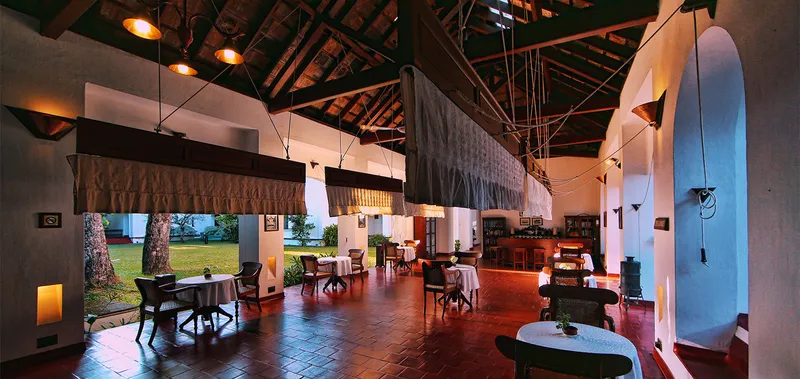
The lounge area at Brunton Boatyard features hand operated punkah, depicting the British era.
A weekend getaway in the unexplored Sindhudurg, experiencing rustic luxury in Coco Shambhala
“The paintings were specially commissioned by co-founder Jose Dominic to narrate the story of those who played a significant role in the creation of Kochi,” points out Shenoi.
One cannot help but notice the original antique pieces in the lounge area–a palanquin and a billiards table. The area also houses a large anchor from a bygone era.
All the 22 rooms in Brunton Boatyard and its bathrooms overlook the sea and offer a closer look at the busy harbour life in the mornings and the stunning sunset in the evenings as the fishing boats return home.
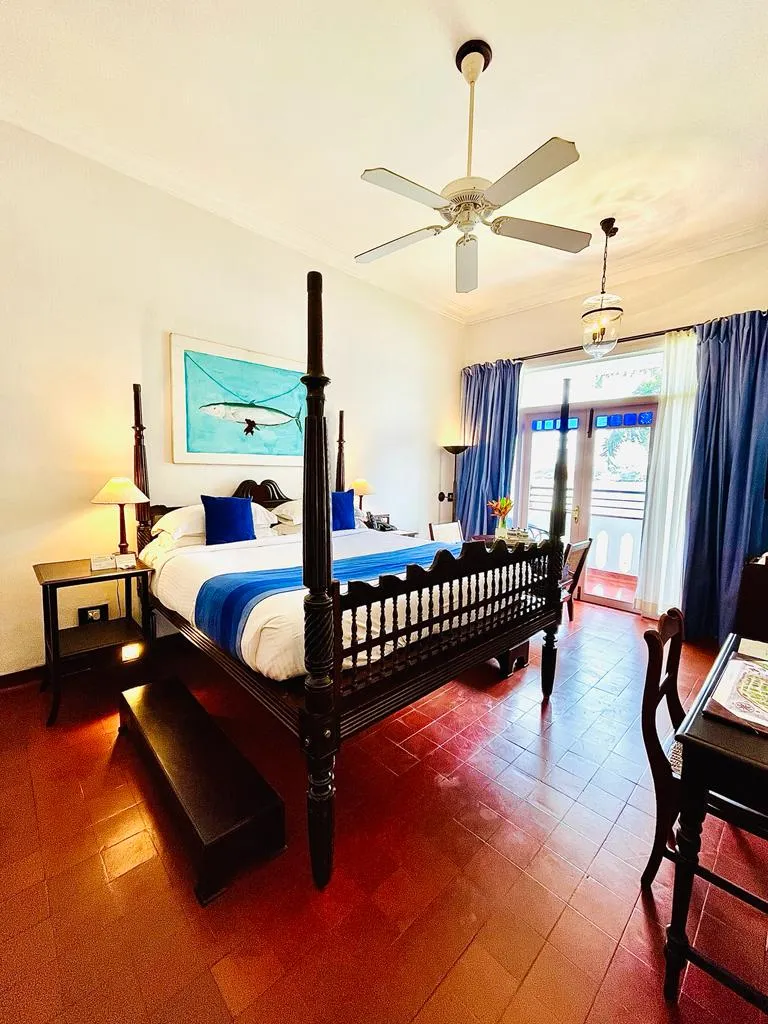
The rooms in Brunton Boatyard feature four poster beds, antique furniture and paintings. The patio opens to the pool in the garden area, and the sea beyond it. | Image: Debolina Biswas
Much like the lobby, the rooms also have teak wood furniture in old-world designs, but with a touch of modern amenities. Each room comprises a foyer, a bedroom, and a patio overlooking the pier and the sea beyond. The bathrooms, which are almost as large as the bedrooms, come with bathtubs and shower cubicles.
The deluxe suite at Brunton Boatyard is spread across three floors and comprises a bedroom, a living room, a dining area, a pantry, a bathroom, a foyer, a patio, and a powder room. If you are looking to go back in time and live the colonial life for a day or two, the suite makes a perfect choice.
The entire property features high wooden ceilings, terracotta floors, and lime plastered walls adorned with vintage photographs. Clay urns, arms, and maps form the rest of the paraphernalia.
Shenoi informs me that the glazed clay urns are sourced from the Chinese, Portuguese and Dutch ships that came to the Malabar coast for spice trade.
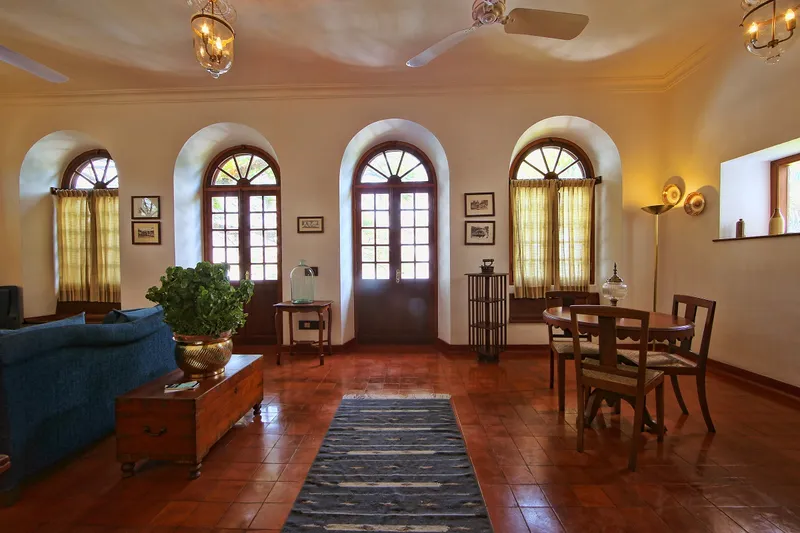
The Brunton Boatyard suite gives a taste of colonial life.
The furniture–including the large and comfortable armchairs, cane chairs, sofas and divans, spice chests in mahogany and teak, and the majestic four-poster beds in each room–have been curated by the owner’s family.
“The collection includes originals and replicas of the old colonial period,” says Shenoi.
Even the raintrees in the courtyard are said to have been brought there by the British.
Fort Kochi has art, history and culture throbbing in every nook and corner. But if you are looking to do something at a more leisurely pace, you can just laze around in the property, soaking in all the history and culture around you. You can also take a ride on the Manta boat–the last surviving boat built by the Brunton family–and go around the different islands nearby.
History on a platter
Besides the architecture and design, there’s also a lot of food to be explored at Brunton Boatyard, which is strongly influenced by Dutch, Portuguese and Jewish cuisine, married beautifully with modern-day Malabar fare.
Brunton Boatyard houses three restaurants–History, Armoury, and Terrace Grill.
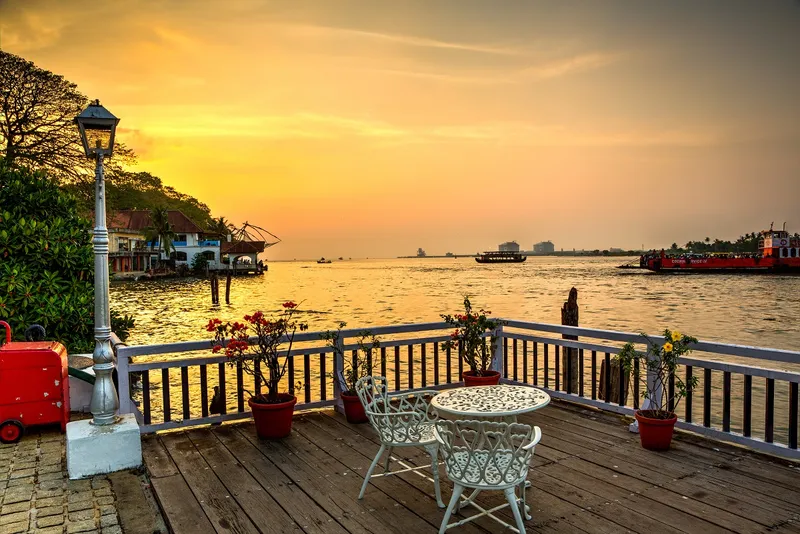
The pier dining experience at Brunton Boatyard is especially curated for each guest, centred around their expectation of cuisine and ambience.
From the house of Miss Nora comes Goa’s modern European restaurant Mystras
Seated on the second floor of the property, the fine-dining restaurant History, as the name suggests, takes its guests on a culinary journey that dates back to centuries ago. Its cuisine is inspired from all the communities that have made a stop at Kochi’s port area.
“More than 32 communities–including the Arabs, Portuguese, Jews, Africans, and Tamil Brahmins, continue to live and thrive in Fort Kochi. The History restaurant is a tribute to all these communities and their cuisine,” Shenoi explains.
YS Life recommends the First Class Railway Mutton curry (mutton shanks slow braised for over five hours in a brass vessel and served with ragi roti and salad) and Prawns Akathe Pathiri (steamed rice flour dough parcels filled with spicy prawns and served with a thick coconut and turmeric dip–an usual accompaniment for Mattancheri-Muslim meals).
One can pair these with modern concoctions from the cocktail menu.
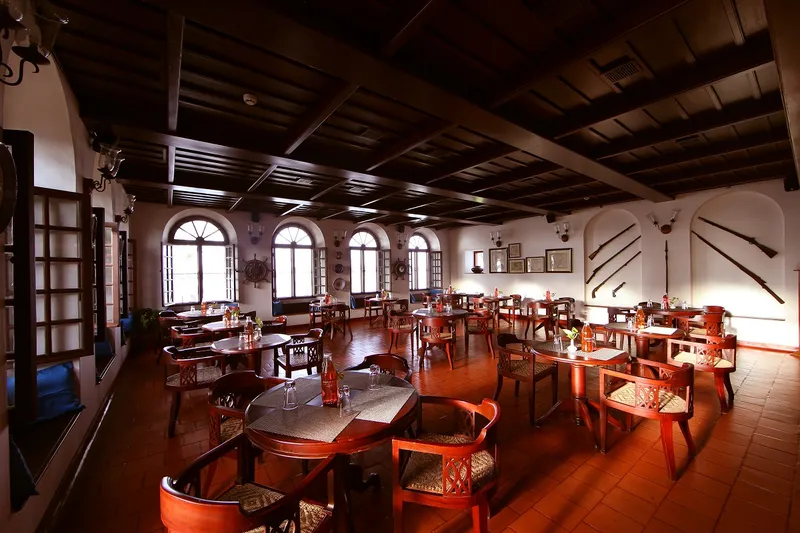
The Armoury restaurant gets its name from the guns and swords adorning the walls, which were believed to be used in the 1857 Mutiny era.
The Armoury restaurant, on the first floor, gets its name from the guns and swords adorning the walls, which were believed to be used in the 1857 Mutiny era.
The restaurant has a vast menu featuring both traditional dishes and contemporary cuisine–ranging from authentic Kerala fish thali to pasta and steak. One can enjoy their meal in the garden area, sipping freshly curated cocktails and beers.
YS Life highly recommends the Karimundan peppered chicken with thattu dosa and fish moilee (local catch, slow cooked in coconut milk and local spices, served with appams).

The Karimundan peppered chicken at Armoury is served with thattu dosa | Image: Debolina Biswas
The open-air restaurant, Terrace Grill, offers the fresh catch of the day, cooked in a marinade of your choice–this is to be relished watching the boats pass by. Terrace Grill is usually shut during the monsoons. So, the best time to enjoy a meal at this restaurant is during the winter months.
Guests can also request a meal at the pier.
“The dining experience is especially curated for each guest, centred around their expectation of cuisine and ambience,” Shenoi says.
During my two nights’ stay, I found myself spending most of my time at the patio, sipping wine and watching the fishing boats sail by.
With its rich heritage and history, one might just confuse their stay at Brunton Boatyard with a night at the museum!
Cost per night (including breakfast): Rs 10,170 - Rs 28,815, depending on the room type and the season.
Edited by Swetha Kannan




![[Exclusive] Being calm in the face of chaos, actor Tamannaah Bhatia finds solace in meditation](https://images.yourstory.com/cs/210/3fb20ae02dc911e9af58c17e6cc3d915/TamannahBhatia1600x800-1719395010347.jpg?mode=crop&crop=faces&ar=1%3A1&format=auto&w=1920&q=75)


